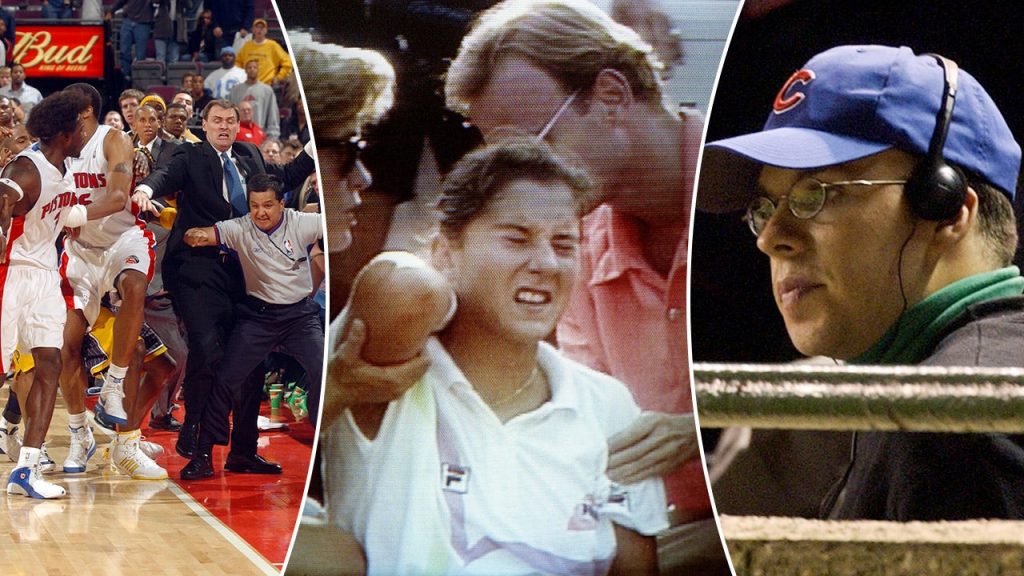The world of sports, while often a source of exhilaration and unity, has also been marred by instances of extreme fan behavior that transcend the boundaries of healthy competition and escalate into scandal and even violence. One recent example involves Philadelphia Eagles fan Ryan Caldwell, whose verbal berating of a female Packers fan highlights a disturbing trend of unruly conduct in stadiums and arenas. This incident, however, is just the tip of the iceberg when considering the history of fan-related controversies that have plagued the sports landscape. From seemingly harmless interventions with devastating consequences to outright physical assaults, the following incidents stand out as some of the most infamous examples of fan misconduct.
The 2003 National League Division Series between the Chicago Cubs and the Florida Marlins witnessed a moment that would forever etch itself into baseball infamy. Steve Bartman, a devoted Cubs fan, inadvertently became the focal point of the franchise’s continued World Series drought when he interfered with a foul ball that Cubs outfielder Moisés Alou was poised to catch. This seemingly innocuous act, while not malicious in intent, had catastrophic consequences. The Cubs, holding a 3-0 lead at the time, subsequently suffered a defensive collapse, allowing eight runs and ultimately losing the game and the series. The incident became inextricably linked to the “Curse of the Billy Goat,” a long-standing superstition surrounding the team’s championship woes. Bartman, vilified by some, became a recluse, declining interviews and public appearances for years, a testament to the immense pressure and scrutiny that can follow even unintentional fan interference.
Fan misconduct is not limited to passive interference. In 1997, during a Monday Night Football game between the Philadelphia Eagles and the San Francisco 49ers, an Eagles fan fired a flare gun into the stands, igniting not only a physical projectile but also a flurry of fistfights and escalating tensions between rival fans. This dangerous act, which endangered the lives of numerous spectators, forced Eagles owner Jeffrie Lurie to publicly condemn the behavior of his own fanbase. The incident served as a stark reminder of the potential for fan actions to create a hostile and unsafe environment, far removed from the spirit of sporting competition. The presence of an on-site court and jail cells at the Eagles’ former stadium, Veterans Stadium, underscored the prevalence of fan-related issues.
The infamous “Malice at the Palace” incident during a 2004 NBA game between the Detroit Pistons and Indiana Pacers stands as a chilling example of how on-court tensions can spill over into the stands, involving both players and fans in a chaotic brawl. A hard foul in the closing seconds of the game triggered a series of escalating confrontations that ultimately led to Pacers forward Ron Artest engaging in physical altercations with Pistons fans. The disturbing images of players fighting fans, coupled with the spectacle of fans throwing drinks and debris at players, became a dark stain on the league’s history. The repercussions were severe, with multiple players receiving suspensions and facing assault charges, and fans receiving lifetime bans from attending Pistons games.
The Cleveland Indians’ ill-fated “10-Cent Beer Night” promotion in 1974 serves as a cautionary tale of how ill-conceived promotional strategies can incite unruly and dangerous behavior. The drastically discounted beer fueled a night of escalating chaos, with drunken fans engaging in various acts of misconduct, including setting off firecrackers and streaking across the field. The situation reached a boiling point in the ninth inning when a fan attempted to steal a player’s cap, sparking a full-blown riot that saw fans wielding makeshift weapons and attacking players. The game was ultimately forfeited, and the incident remains a stark reminder of the potential for alcohol-fueled fan behavior to spiral out of control, endangering players and fellow spectators.
Perhaps one of the most disturbing incidents of fan misconduct in sports history occurred in 1993 when tennis star Monica Seles was stabbed by a fan during a match. Günter Parche, a fan of Seles’ rival Steffi Graf, ran onto the court and stabbed Seles in the back, an act driven by the perverse desire to see Graf regain the world No. 1 ranking. This shocking act of violence not only physically injured Seles but also left deep emotional scars, leading to a two-year hiatus from the sport and a vow to never play in Germany again. The incident highlighted the vulnerability of athletes to obsessive fans and the potential for extreme acts of violence motivated by misguided loyalty or misplaced aggression.
These instances of extreme fan behavior, ranging from seemingly harmless interference to acts of violence, underscore the importance of maintaining a safe and respectful environment within the realm of sports. While passionate fandom is an integral part of the sporting experience, it must be tempered by a sense of responsibility and respect for the athletes, officials, and fellow fans. The incidents described above serve as reminders of the potential consequences when the line between enthusiastic support and unruly behavior is crossed, and they highlight the ongoing need for measures to ensure that sporting events remain enjoyable and safe for all involved.

